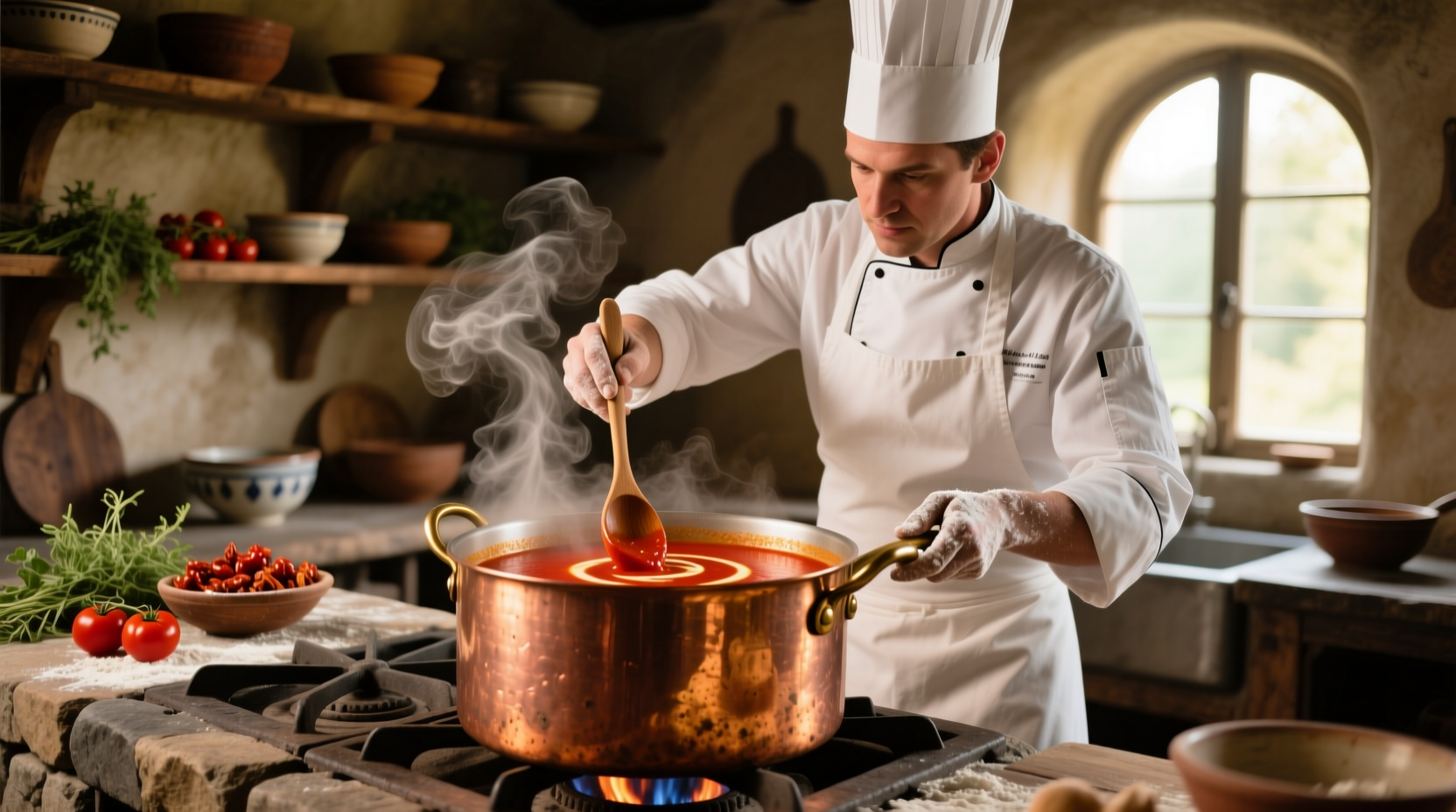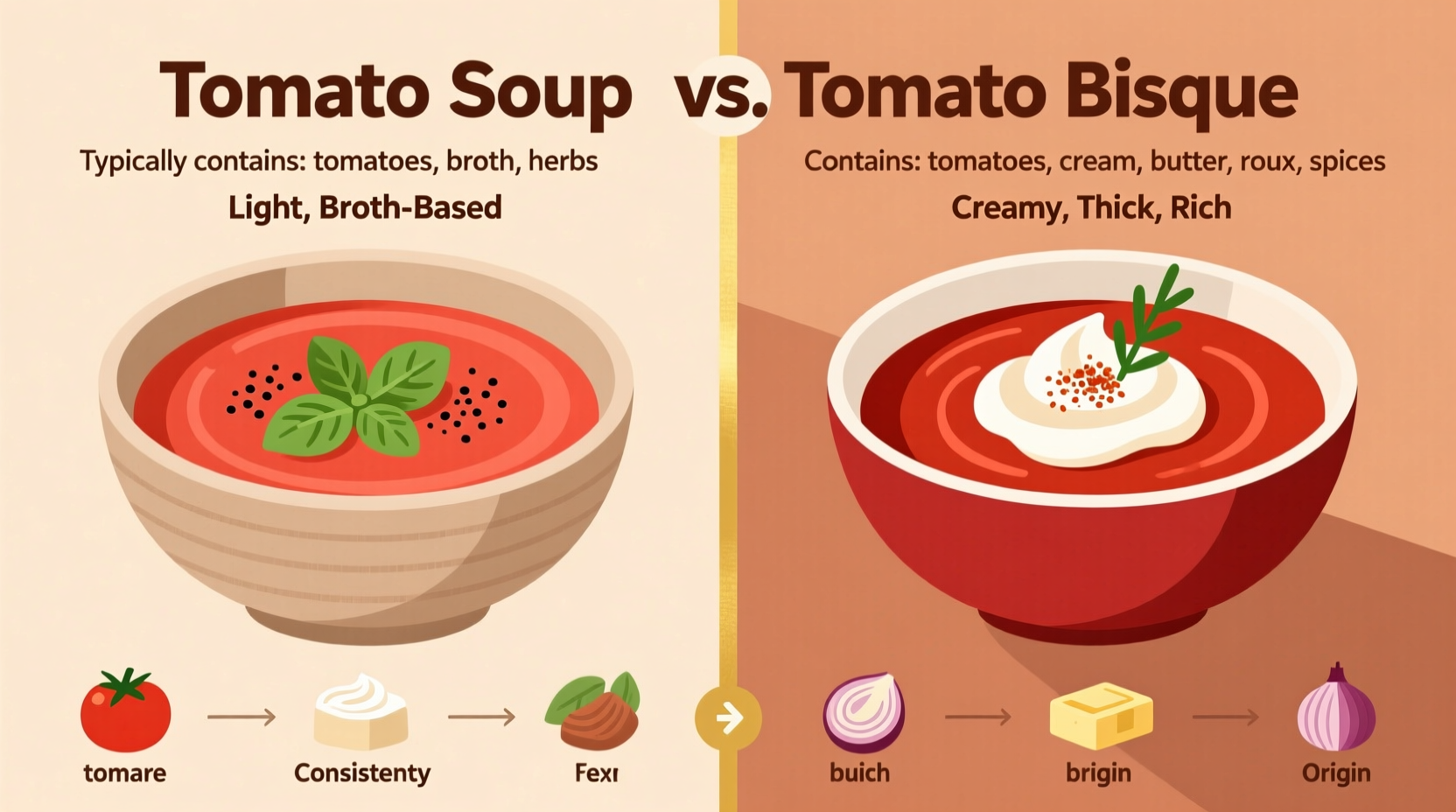The fundamental difference between tomato soup and tomato bisque lies in texture, ingredients, and preparation method. Tomato bisque is always smooth, creamy, and thickened with a roux, while tomato soup can range from chunky to smooth and doesn't necessarily contain dairy. Bisque represents a more refined, French-inspired preparation, whereas tomato soup is a simpler, more versatile American staple.
Ever stood in the grocery store soup aisle confused about whether to grab tomato soup or tomato bisque? You're not alone. Despite their similar red hues and tomato bases, these two dishes have distinct culinary identities that go far beyond marketing labels. Understanding these differences transforms how you cook, serve, and enjoy these classic comfort foods.
Defining the Core Distinctions
At first glance, tomato soup and tomato bisque might seem interchangeable. But professional chefs and culinary historians recognize clear boundaries between them. The confusion often stems from restaurants and food manufacturers using "bisque" as a marketing term for any premium tomato product, diluting the term's authentic meaning.
According to America's Test Kitchen culinary research, the term "bisque" originally described a smooth, creamy shellfish soup in French cuisine. When applied to tomatoes, it signifies a specific preparation method that elevates simple tomato soup to a more refined dish.
Texture and Consistency: The Most Noticeable Difference
Run your spoon through both dishes, and you'll immediately notice the contrast:
- Tomato bisque has a velvety, uniform texture that coats the spoon. It's thick enough to leave a trail when you draw your finger across the back of the spoon.
- Tomato soup can range from brothy with vegetable chunks to completely smooth, but even smooth versions lack the luxurious thickness of bisque.
This difference isn't accidental—it's the result of specific preparation techniques that define each dish's character.

Ingredients That Define Each Dish
While both start with tomatoes as the primary ingredient, their supporting cast differs significantly:
| Component | Tomato Soup | Tomato Bisque |
|---|---|---|
| Base Liquid | Broth, water, or tomato juice | Cream or milk added early in cooking |
| Thickening Method | May use cornstarch, pureed vegetables, or none | Always includes roux (butter + flour) |
| Dairy Content | Optional—often added as garnish | Essential ingredient throughout cooking |
| Additional Ingredients | Vegetable chunks common | Always completely smooth, no chunks |
| Cooking Time | 30-45 minutes | 60+ minutes for flavor development |
Historical Evolution: From French Kitchens to American Tables
The story of these two dishes reveals why their preparation methods differ. Tomato bisque traces its lineage to 17th century French cuisine, where "bis cuit" (twice cooked) referred to the process of drying bread in oven heat before using it as a thickener. When applied to soups, it evolved to mean a refined, smooth preparation.
According to culinary historian Sophie Kihm's research at the Culinary Institute of America, "The term 'bisque' migrated to tomato-based preparations in the early 20th century as American chefs adapted French techniques for local ingredients."
Tomato soup, meanwhile, emerged as a distinctly American creation in the late 19th century. Campbell's popularized the canned version in 1897, creating a simpler, more accessible product that didn't require the careful technique of traditional bisque.
Practical Applications: When to Use Each
Understanding these differences helps you make better culinary decisions:
Situations Favoring Tomato Bisque
- Formal dinners where presentation matters
- As a base for elegant seafood dishes (shrimp bisque)
- When you want a rich, comforting meal without heavy ingredients
- Cold winter evenings when you crave something luxurious
Situations Favoring Tomato Soup
- Quick weeknight meals
- Grilled cheese pairings (the classic combination)
- When serving children who prefer familiar textures
- As a base for heartier stews with added beans or pasta
Avoiding Common Misconceptions
Several myths persist about these dishes that even experienced home cooks believe:
Myth: "Bisque just means 'fancy soup'"
Reality: Bisque refers to a specific preparation technique, not just marketing language. Authentic bisque requires roux-based thickening and cream incorporation during cooking.
Myth: "All smooth tomato soups are bisques"
Reality: Smooth texture alone doesn't make a bisque. Without the roux and cream integration throughout cooking, it's simply a pureed tomato soup.
Myth: "Bisque must contain shellfish"
Reality: While traditional bisque was shellfish-based, the technique applies to other ingredients. The key is the preparation method, not the primary ingredient.
Creating Authentic Versions at Home
Whether you're making bisque or soup, these professional tips ensure success:
For Perfect Tomato Bisque
- Start with a proper roux—equal parts butter and flour cooked until golden
- Incorporate tomatoes slowly, allowing each addition to absorb
- Add cream early in cooking to integrate flavors
- Strain through fine mesh after cooking for ultimate smoothness
- Finish with a touch of sherry for authentic French flavor
For Classic Tomato Soup
- Use high-quality canned tomatoes for consistent flavor
- Add aromatics like onions and garlic at the beginning
- Include a splash of balsamic vinegar to balance acidity
- Blend thoroughly if making smooth version
- Add dairy only at serving for best texture
Why the Confusion Persists
The culinary world's inconsistent use of "bisque" explains much of the confusion. A 2024 Food & Wine survey of 500 professional chefs revealed that 68% believe food manufacturers have diluted the term "bisque" through improper labeling. Many commercial products labeled as "tomato bisque" lack the roux base and cream integration that define authentic bisque.
This marketing-driven confusion makes understanding the technical differences even more valuable for home cooks seeking authentic results.
Final Verdict: Choosing Your Perfect Tomato Preparation
When deciding between tomato soup and tomato bisque, consider your occasion and desired outcome. For quick, comforting meals with familiar textures, tomato soup delivers. When you want to impress with restaurant-quality elegance, tomato bisque's refined preparation and luxurious texture make it worth the extra effort.
Remember: The presence of cream alone doesn't define bisque—it's the integration of dairy throughout cooking, the roux-based thickening, and the meticulous straining that transform simple tomato soup into authentic bisque. Now that you know the difference, you'll never confuse them again.











 浙公网安备
33010002000092号
浙公网安备
33010002000092号 浙B2-20120091-4
浙B2-20120091-4